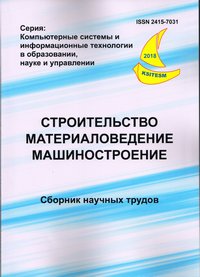Modeling of production capacity of enterprises which release different ecologically clean products
DOI:
https://doi.org/10.30838/P.CMM.2415.270818.25.225Keywords:
production capacity of enterprises, operational stability, production system, modeling of crisis situations, modeling systemAbstract
Goal. When using limited production resources critical and continuous interaction of enterprises in a single production system in the interests of obtaining mutual benefits in solving common problems to meet the needs of society. The production system will work efficiently, if its enterprises will operate stably. The purpose of the work is to investigate the stability of three separate enterprises and their behavior in crisis situations. Method. The output parameter characterizing the enterprise's performance is production capacity. When variable capital intensity of the main production assets of the enterprise, the production capacity is described by the system of two ordinary differential equations of the first order. To analyze the stability of the operation of an enterprise, it is necessary to obtain an analytical solution and a solution in the modeling system. A simulation scheme is formed and the user program is modeled. The simulation results are presented as graphs. In addition, there is a text editor that fixes the numerical data of the simulation results. Results. The analytical solution of the differential equation of production capacity with variable capital stock is obtained. A simulation scheme was created and graphs of production capacity of each enterprise were obtained. Crisis modeling is done for each enterprise. It is established that, despite the significant difference in the parameters of enterprises, their production capacity is not much different. For sustainable operation, enterprises must invest in the development of the main production. Enterprises can work in a single production system. Scientific novelty. A new approach to the formation of production systems is proposed. Before creating a production system, it is necessary to find out the possibilities of entering it: to check the stability of their functioning and behavior in crisis situations. Practical significance. The new approach will increase the efficiency of the production system.References
Ershova N.M., Lavrenyuk I.V. and Gerasimenko S.V. Shybko O.N. Modelirovaniye krizisnykh situatsiy v firme na modeli yeye zhyznennogo tsikla [Modeling of crisis situations in a firm on a model of its life cycle], Dnipro, PGASA, 2009, pp.37-43 (in Russian).
Kurshev V.N. Teoriya optimalnogo upravleniya ekonomicheskimi sistemami [Theory of optimal control of economic systems: Proc. manual] Kazan, 2003, 114 p. (in Russian).
Mikryukov V.Yu. Teoriya vzaimodeystviya ekonomicheskikh subektov [Theory of interaction of economic subjects], Moscow: Vuzovskaya kniga, 1999, 96 p. (in Russian).
Sirazetdinov T.K. Dinamicheskoye modelirovaniye ekonomicheskikh obektov [Dynamic modeling of economic objects], Kazan: Fan Publ., 1996, 223 p. (in Russian).
Kartashov B.A. Sistemy avtomaticheskogo regulirovaniya: praktikum po matematicheskomu modelirovaniyu [Automatic control systems: a workshop on mathematical modeling]. Rostov na Donu: Feniks Publ., 2015, 458 p. (in Russian).
Shybko, O.N. Vybor osnovnogo pokazatelya kharakteristiki zhyznennogo tsikla stroitelnoy firmy [The choice of the main indicator of the characteristics of the life cycle of a construction company], Dnipropetrovsk: Nauka i Osvita, 2006, issue 7: Ekonomichni Nauky, 2006, pp. 95-97 (in Russian).
Downloads
Published
Issue
Section
License
Редакція Видання категорично засуджує прояви плагіату в статтях та вживає всіх можливих заходів для його недопущення. Плагіат розглядається як форма порушення авторських прав і наукової етики.
При виявлені у статті більш ніж 25% запозиченого тексту без відповідних посилань та використання лапок, стаття кваліфікується як така, що містить плагіат. У цьому випадку стаття більше не розглядається редакцією, а автор отримує перше попередження.
Автори, в статтях яких повторно виявлено плагіат, не зможуть публікуватися в усіх журналах Видавництва ДВНЗ «Придніпровська державна академія будівництва та архітектури».
Автори, які публікуються у цьому журналі, погоджуються з наступними умовами:
- Автори залишають за собою право на авторство своєї роботи та передають журналу право першої публікації цієї роботи на умовах ліцензії Creative Commons Attribution License, котра дозволяє іншим особам вільно розповсюджувати опубліковану роботу з обов'язковим посиланням на авторів оригінальної роботи та першу публікацію роботи у цьому журналі.
- Автори мають право укладати самостійні додаткові угоди щодо неексклюзивного розповсюдження роботи у тому вигляді, в якому вона була опублікована цим журналом (наприклад, розміщувати роботу в електронному сховищі установи або публікувати у складі монографії), за умови збереження посилання на першу публікацію роботи у цьому журналі.
- Політика журналу дозволяє і заохочує розміщення авторами в мережі Інтернет (наприклад, у сховищах установ або на особистих веб-сайтах) рукопису роботи, як до подання цього рукопису до редакції, так і під час його редакційного опрацювання, оскільки це сприяє виникненню продуктивної наукової дискусії та позитивно позначається на оперативності та динаміці цитування опублікованої роботи (див. The Effect of Open Access).

